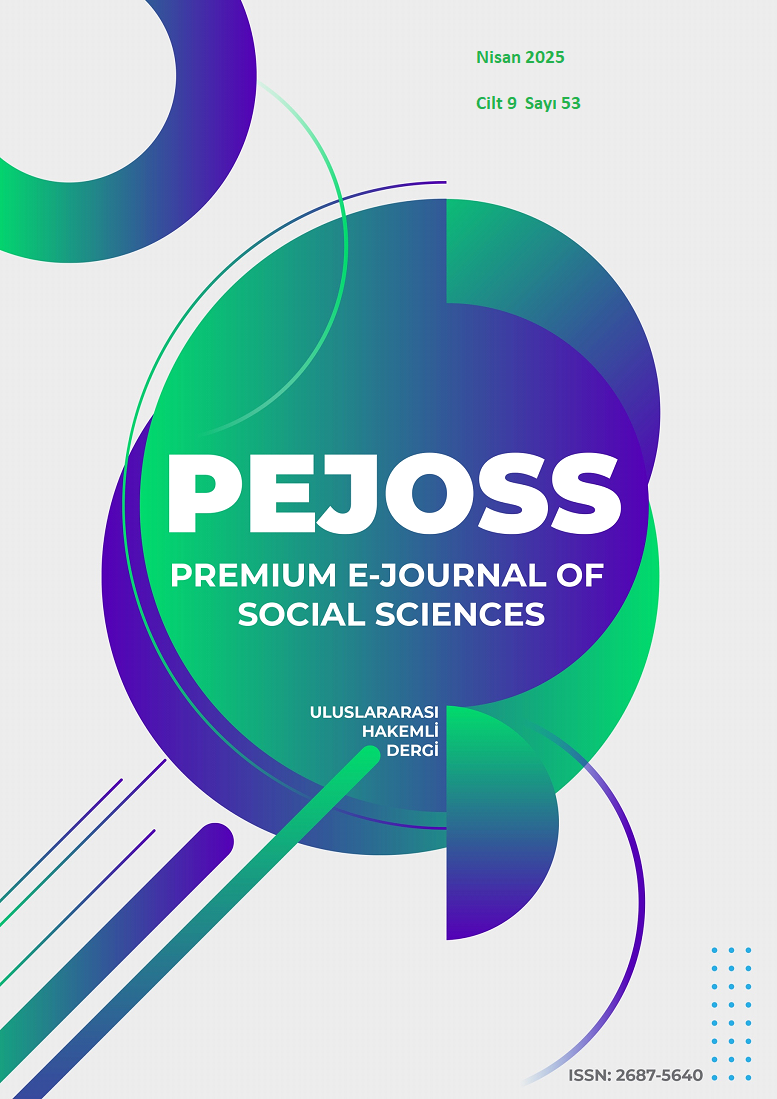Evaluation According To Borderline Personality Disorder And Masterson Approach Perspective
DOI:
https://doi.org/10.5281/zenodo.15319608Keywords:
Borderline Personality Disorder, Masterson Approach, Personality DisorderAbstract
Borderline personality disorder is a serious mental disorder that usually begins to emerge in early adulthood, in which there are inconsistencies in mood, instability in behavior, instability in interpersonal relationships in their social lives, and inability to control impulses. The subject of this study is to explain in detail the "Borderline Personality Disorder", which has a long-term treatment process, to include its characteristics and to discuss the perspectives of different psychological approaches applied in its treatment on borderline personality disorder. For this reason, the definition of personality is given primarily, experiences in childhood, parenting attitudes that are effective in the formation of personality are emphasized, and the negative development of personality with the effect of environmental factors together with the presence of obsessions or compulsions on psychological or sexual issues experienced in this period explains the cause of personality disorder. Afterwards, the diagnostic criteria for borderline personality disorder are mentioned, its characteristics are given and its treatment is mentioned. Finally, the therapy school used in the treatment of borderline personality disorder is explained and the perspective of the Masterson Approach to borderline personality disorder is examined. The aim of this study is to define borderline personality characteristics and to examine and present the studies conducted and researched on the perspective of this therapy school on borderline personality disorder. It is thought that the conducted review article provides depth to the relevant literature studies by going into the details of the existing studies on borderline personality disorder, its causality and the relationship between the Masterson psychological approach, and reveals the importance of the study.
Downloads
References
Akpınar, F. (2010). Borderline kişilik bozukluğu olan bireylerin öfke tarzları ve saldırganlık davranışı üzerine bir inceleme [Yüksek lisans tezi, Maltepe Üniversitesi Sosyal Bilimler Enstitüsü].
Amerikan Psikiyatri Birliği. (2000). Ruhsal bozuklukların tanımsal ve sayısal el kitabı: DSM-IV-TR (E. Köroğlu, Çev.). Hekimler Birliği Yayınları. (İlk basım 1994)
Amerikan Psikiyatri Birliği. (2014). Ruhsal bozuklukların tanısal ve sayımsal elkitabı: DSM-5 tanı ölçütleri başvuru elkitabı (E. Köroğlu, Çev.). Hekimler Yayın Birliği. (İlk basım 2013)
Aydın, B. (2010). Masterson yaklaşımında borderline kişilik bozukluğuna gelişimsel yaklaşım [Bitirme projesi, İstanbul Ticaret Üniversitesi Sosyal Bilimler Enstitüsü].
Berens, L. V. (1999). Sixteen personality types: Descriptions for self-discovery. Telos Yayınları.
Cüceloğlu, D. (1993). İnsan ve davranışı. Remzi Kitabevi.
Derin, G., & Öztürk, E. (2018). Dissosiyatif bozukluklar ve sınırda (borderline) kişilik bozukluğunda ruhsal travma. Bartın Üniversitesi Edebiyat Fakültesi Dergisi, 3(3), 29–41.
Grant, B.F., Chou, S.P., Goldstein, R.B., Huang, B., Stinson F.S., Saha, T.D., Ruan, W.J. (2008). Prevalance, correlates, disability, and comorbidity of DSM-IV borderline personality disorder. Results from the wave 2 national epidemiologic survey on alcohol and related conditions. Journal of Clinical Psychiatry, 69(4), 533-545.
Güleç, E. (2010). Kişilik yapısı ve örgüt içerisindeki güç mesafesi [Yüksek lisans tezi, Abant İzzet Baysal Üniversitesi Sosyal Bilimler Enstitüsü].
Eren, N. (2010). Personality disorders and nursing interventions – Part I. Journal of Psychiatric Nursing, 1(1), 33–38.
Kahveci, S. (2016). Borderline kişilik bozukluğunda zihin kuramı ve çocukluk çağı travması arasındaki ilişki [Yüksek lisans tezi, Üsküdar Üniversitesi Sosyal Bilimler Enstitüsü].
Karakoç, T. (2014). Borderline (sınırda) kişilik bozukluğu olan hastalarda talamus hacimleri ve klinik değişkenlerle ilişkisi [Uzmanlık tezi, Fırat Üniversitesi Tıp Fakültesi Ruh Sağlığı ve Hastalıkları Anabilim Dalı].
Kernberg, O. F. (1984). Severe personality disorders: Psychotherapeutic strategies. Yale Üniversitesi Yayınları.
Klein, R. (1989). The art of confrontation. İçinde J. F. Masterson & R. Klein (Der.), Psychotherapy of the disorders of the self: The Masterson approach (s. 117–142). Brunner/Mazel Yayınları.
Kring, A. M., Johnson, S. L., Davison, G. C., & Neale, J. M. (2017). Anormal psikoloji / Psikopatoloji (S. G. Şahin, Ed. & Çev.). Nobel Akademik Yayıncılık.
Kutlu, M. (2018). Borderline Kişilik Bozukluğu: Bir Gözden Geçirme. Medeniyet Araştırmaları Dergisi, 3(5), 11-20.
Masterson, J. F. (1972). Treatment of the borderline adolescent: A developmental approach. Brunner/Mazel Yayınları.
Masterson, J. F. (1984). The psychiatric dilemma of adolescence (2. baskı). Brunner/Mazel Yayınları.
Masterson, J. F. (2008). Bağlanma kuramı ve nörobiyolojik kendilik gelişimi açısından kişilik bozuklukları: Klinik bir bütünleştirme (H. Şentürk, Çev.). Litera Yayıncılık.
Masterson, J. F., Lulow, W. V., & Castello, J. L. (1982). The test of time: Borderline adolescent to functioning adult. Adolescent Psychiatry, 10, 494–522.
Masterson, J. F., & Klein, R. (1989). Psychotherapy of the disorders of the self: The Masterson approach. Brunner/Mazel Yayınları.
Öztürk, O. (2004). Ruh sağlığı ve bozuklukları. Nobel Tıp Kitabevleri.
Philipsen, A., Limberger, M. F., Lieb, K., Feige, B., Kleindienst, N., Ebner-Priemer, U., Barth, J., Schmahl, C., & Bohus, M. (2008). Attention-deficit hyperactivity disorder as a potentially aggravating factor in borderline personality disorder. The British Journal of Psychiatry, 192(2), 118–123. https://doi.org/10.1192/bjp.bp.107.035782
Ryckman, R. M. (2004). Theories of personality (8. baskı). Wadsworth/Thomson Learning Yayınları.
Sargın, A. E., & Sargın, M. (2015). Bir gözden geçirme: Sınırda kişilik bozukluğu ve Diyalektik Davranışçı Terapi. Türkiye Klinikleri Psikiyatri – Özel Konular, 8(4), 38–46. https://www.turkiyeklinikleri.com/article/en-bir-gozden-gecirme-sinirda-kisilik-bozuklugu-ve-diyalektik-davranisci-terapi-73138.html
Schultz, D. P., & Schultz, S. E. (2020). Modern psikoloji tarihi (Y. Aslay, Çev.; 8. baskı). Kaknüs Yayınları.
Semiz, Ü. B., Başoğlu, C., Ebrinç, S., Ergün, B. M., Noyan, C. O., & Çetin, M. (2005). Sınır kişilik bozukluğu hastalarında vücut dismorfik bozukluğu, travma ve disosiyasyon: Bir ön çalışma. Klinik Psikofarmakoloji Bülteni, 15(2), 65–70.
Şahin, D. (2009). Kişilik bozuklukları. Klinik Gelişim, 22(4), 45–55.
Tunç, P. (2016). Borderline kişilik bozukluğunda depresif semptom ve çocukluk çağı travmalarının dürtüsellik, kendine zarar verme ve intihar davranışları üzerindeki yordayıcı etkisi [Doktora tezi, İstanbul Arel Üniversitesi Sosyal Bilimler Enstitüsü].
Tuncer, M., Öner Kapısız, Ö., & Dönmez, N. (2018). J. F. Masterson yaklaşımı çerçevesinde şizoid kendilik bozukluğu ve bu yaklaşım çerçevesinde tanımlanmış bir danışanın psikoterapisinin uygulanması. Türkiye Bütüncül Psikoterapi Dergisi, 1(1), 79–99. https://dergipark.org.tr/tr/pub/bpd/issue/31051/373145
Downloads
Published
How to Cite
Issue
Section
License
Copyright (c) 2025 Premium e-Journal of Social Science (PEJOSS)

This work is licensed under a Creative Commons Attribution 4.0 International License.


